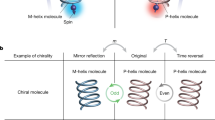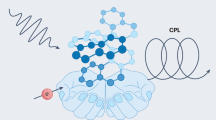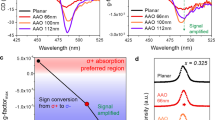Abstract
Creating chirality in achiral graphene and other two-dimensional materials has attracted broad scientific interest due to their potential application in advanced optics, electronics and spintronics. However, investigations into their optical activities and related chiro-electronic properties are constrained by experimental challenges, particularly in the precise control over the chirality of these materials. Here a universal wax-aided immersion method is developed to yield graphene rolls with controllable chiral angles, and the method can be generalized in other two-dimensional materials for high-yield fabrication. The left-handed and right-handed rolls exhibit optical activity and excellent spin selectivity effects with a spin polarization over 90% at room temperature. The discovery of tunable chirality-induced spin selectivity in tailored roll-shaped allotropes, achievable only through precise control of chirality, distinguishes itself from other carbon materials or existing chiral materials. Our Dirac fermion model shows that the electrons moving predominately along one side of the chiral roll develop a preferred spin polarization, and the rolling-chirality-induced spin selectivity is a result of this finite spin selectivity effect. Our method opens up opportunities for endowing achiral two-dimensional materials with tunable chirality, and may enable the emergence of quantum behaviours and room-temperature spintronic technologies.
This is a preview of subscription content, access via your institution
Access options
Access Nature and 54 other Nature Portfolio journals
Get Nature+, our best-value online-access subscription
$32.99 / 30 days
cancel any time
Subscribe to this journal
Receive 12 print issues and online access
$259.00 per year
only $21.58 per issue
Buy this article
- Purchase on SpringerLink
- Instant access to full article PDF
Prices may be subject to local taxes which are calculated during checkout




Similar content being viewed by others
Data availability
All data are available in the Article and its Supplementary Information, or from the corresponding authors upon reasonable request.
References
Pan, H., Feng, Y. & Lin, J. Ab initio study of electronic and optical properties of multiwall carbon nanotube structures made up of a single rolled-up graphite sheet. Phys. Rev. B 72, 085415 (2005).
Hassanzadazar, M., Ahmadi, M. T., Ismail, R. & Goudarzi, H. Electrical property analytical prediction on Archimedes chiral carbon nanoscrolls. J. Electron. Mater. 45, 5404–5411 (2016).
Xia, D. et al. Fabrication of carbon nanoscrolls from monolayer graphene. Small 6, 2010–2019 (2010).
Liu, B. L., Wu, F. Q., Gui, H., Zheng, M. & Zhou, C. W. Chirality-controlled synthesis and applications of single-wall carbon nanotubes. ACS Nano 11, 31–53 (2017).
Yang, F. et al. Chirality pure carbon nanotubes: growth, sorting, and characterization. Chem. Rev. 120, 2693–2758 (2020).
Liu, M. H., Zhang, L. & Wang, T. Y. Supramolecular chirality in self-assembled systems. Chem. Rev. 115, 7304–7397 (2015).
Knoppe, S. & Burgi, T. Chirality in thiolate-protected gold clusters. Acc. Chem. Res. 47, 1318–1326 (2014).
Yokoyama, A., Yoshida, M., Ishii, A. & Kato, Y. K. Giant circular dichroism in individual carbon nanotubes induced by extrinsic chirality. Phys. Rev. X 4, 011005 (2014).
Zhu, H. Y. & Yakobson, B. I. Creating chirality in the nearly two dimensions. Nat. Mater. 23, 316–322 (2024).
Purcell-Milton, F. et al. Induction of chirality in two-dimensional nanomaterials: chiral 2D MoS2 nanostructures. ACS Nano 12, 954–964 (2018).
Zhang, F. R., Ding, C. X., Zhou, J. H. & Yao, Y. G. Chiral edge plasmons in quantum anomalous Hall insulators. Preprint at https://doi.org/10.48550/arXiv.2404.13930 (2024).
Pan, M. X., Zeng, H., Wang, E. Q. & Huang, H. Q. Intrinsic orbital origin for the chirality-dependent nonlinear planar Hall effect of topological nodal fermions in chiral crystals. Preprint at https://doi.org/10.48550/arXiv.2405.07529 (2024).
Han, W., Kawakami, R. K., Gmitra, M. & Fabian, J. Graphene spintronics. Nat. Nanotechnol. 9, 794–807 (2014).
Novoselov, K. S. et al. Electric field effect in atomically thin carbon films. Science 306, 666–669 (2004).
Novoselov, K. S. et al. A roadmap for graphene. Nature 490, 192–200 (2012).
Kuemmeth, F., Ilani, S., Ralph, D. C. & McEuen, P. L. Coupling of spin and orbital motion of electrons in carbon nanotubes. Nature 452, 448–452 (2008).
Tombros, N. et al. Electronic spin transport and spin precession in single graphene layers at room temperature. Nature 448, 571–574 (2007).
Lin, X. Y., Yang, W., Wang, K. L. & Zhao, W. S. Two-dimensional spintronics for low-power electronics. Nat. Electron. 2, 274–283 (2019).
Viculis, L. M., Mack, J. J. & Kaner, R. B. A chemical route to carbon nanoscrolls. Science 299, 1361 (2003).
Xie, X. et al. Controlled fabrication of high-quality carbon nanoscroll from monolayer graphene. Nano Lett. 9, 2565–2570 (2009).
Zhao, B. et al. High-order superlattices by rolling up van der Waals heterostructures. Nature 591, 385–390 (2021).
Cui, X. P. et al. Rolling up transition metal dichalcogenide nanoscroll via one drop of ethanol. Nat. Commun. 9, 1301 (2018).
Liu, P. W. et al. Layered and scrolled nanocomposites with aligned semi-infinite graphene inclusions at the platelet limit. Science 353, 364–367 (2016).
You, Y. M., Ni, Z. H., Yu, T. & Shen, Z. X. Edge chirality determination of graphene by Raman spectroscopy. Appl. Phys. Lett. 93, 163112 (2008).
Sun, L. Z. et al. Hetero-site nucleation for growing twisted bilayer graphene with a wide range of twist angles. Nat. Commun. 12, 2391 (2021).
Parchaňský, V., Kapitán, J. & Bouř, P. Inspecting chiral molecules by Raman optical activity spectroscopy. RSC Adv. 4, 57125–57136 (2014).
Barron, L. D. & Buckingham, A. D. Rayleigh and Raman scattering from optically active molecules. Mol. Phys. 20, 1111–1119 (1971).
Lu, H. P. et al. Spin-dependent charge transport through 2D chiral hybrid lead-iodide perovskites. Sci. Adv. 5, eaay0571 (2019).
Kim, Y. H. et al. Chiral-induced spin selectivity enables a room-temperature spin light-emitting diode. Science 371, 1129–1133 (2021).
Huizi-Rayo, U. et al. An ideal spin filter: long-range, high-spin selectivity in chiral helicoidal 3-dimensional metal organic frameworks. Nano Lett. 20, 8476–8482 (2020).
Rebergen, M. P. A Study of Induced Spin Selectivity in Chiral Molecules. MSc thesis, Delft Univ. of Technology (2018).
Li, X. P., Nan, J. & Pan, X. C. Chiral induced spin selectivity as a spontaneous intertwined order. Phys. Rev. Lett. 125, 263002 (2020).
Liu, Y. Z., Xiao, J. W., Koo, J. & Yan, B. H. Chirality-driven topological electronic structure of DNA-like materials. Nat. Mater. 20, 638–644 (2021).
Steele, G. A. et al. Large spin-orbit coupling in carbon nanotubes. Nat. Commun. 4, 1573 (2013).
Kane, C. L. & Mele, E. J. Quantum spin Hall effect in graphene. Phys. Rev. Lett. 95, 226801 (2005).
Zhang, G. F., Li, Y. & Wu, C. J. Honeycomb lattice with multiorbital structure: topological and quantum anomalous Hall insulators with large gaps. Phys. Rev. B 90, 075114 (2014).
Naaman, R., Paltiel, Y. & Waldeck, D. H. Chiral molecules and the electron spin. Nat. Rev. Chem. 3, 250–260 (2019).
Hao, Y. F. et al. The role of surface oxygen in the growth of large single-crystal graphene on copper. Science 342, 720–723 (2013).
Acknowledgements
W.H. was supported by the National Key Research and Development Program (2022YFB3603800), National Natural Science Foundation of China (52121002, U21A6002 and T2441002) and Haihe Laboratory of Sustainable Chemical Transformations. Y. Shen was supported by the National Natural Science Foundation of China (22375141, 51473116 and 51103094). Xiaopeng Li was supported by the National Key Research and Development Program (2021YFA1400900) and National Natural Science Foundation of China (11934002). X.G. was supported by the National Natural Science Foundation of China (22275042). Q.L. was supported by the National Natural Science Foundation of China (22174098). S.D. was supported by the National Key Research and Development Program (2024YFA1209600) and National Natural Science Foundation of China (52373250 and 52003190). S.L. was supported by the National Natural Science Foundation of China (52073208 and 52473319). We thank J. Qu for discussions on the experiment of the fabrication of graphene rolls. We thank H. Ren and W. Gao for their assistance in device fabrication. Xiaopeng Li acknowledges encouraging discussions with X. Xie.
Author information
Authors and Affiliations
Contributions
Y. Shen, S.L. and W.H. conceived the idea and designed the experiments. E.Z. fabricated the graphene rolls; conducted the characterizations, ROA test and mCP-AFM tests; analysed the data; and participated in writing the manuscript. S.D. designed the CISS characterization, made the magnetoresistance test, took part in the mechanistic discussions and revised the manuscript. Xiaopeng Li provided a theoretical model for the electronic transport and participated in writing the manuscript. X.M. and Q.L. constructed the Raman spectrometer and performed the ROA test. X.G. participated in writing the manuscript and took part in the mechanistic discussions. L.L. conducted the mCP-AFM tests. S.C. helped in developing the graphene roll fabrication process. G.F. and Y. Song participated in the TEM analysis. Xiaojuan Li and Y.X. assisted in the fabrication of graphene rolls. Z.W. and K.X. contributed to transverse spin-valve device fabrication or analysis. X. Liu and X.Z. contributed to the second harmonic generation test of the chiral graphene roll. R.Z. and Q.J. contributed to single-walled carbon nanotube fabrication. W.M., Y.Z., Q.Z., B.W., J.L., J.Y. and Y.Y. participated in writing and editing the manuscript. W.H., Q.L., Y. Shen and S.L. supervised the project and edited the manuscript. All the authors took part in the discussion and writing.
Corresponding authors
Ethics declarations
Competing interests
The authors declare no competing interests.
Peer review
Peer review information
Nature Materials thanks Xinliang Feng, Kian Ping Loh and the other, anonymous, reviewer(s) for their contribution to the peer review of this work.
Additional information
Publisher’s note Springer Nature remains neutral with regard to jurisdictional claims in published maps and institutional affiliations.
Supplementary information
Supplementary Information
Supplementary Notes 1–7, Figs. 1–45, Tables 1–3 and references.
Rights and permissions
Springer Nature or its licensor (e.g. a society or other partner) holds exclusive rights to this article under a publishing agreement with the author(s) or other rightsholder(s); author self-archiving of the accepted manuscript version of this article is solely governed by the terms of such publishing agreement and applicable law.
About this article
Cite this article
Zhang, E., Ding, S., Li, X. et al. Graphene rolls with tunable chirality. Nat. Mater. 24, 377–383 (2025). https://doi.org/10.1038/s41563-025-02127-8
Received:
Accepted:
Published:
Issue date:
DOI: https://doi.org/10.1038/s41563-025-02127-8
This article is cited by
-
Rolling carbon on a rock
Nature Materials (2025)
-
Recent advances in layer engineering and controllable fabrication of graphene, h-BN, and transition metal dichalcogenides
Science China Materials (2025)



